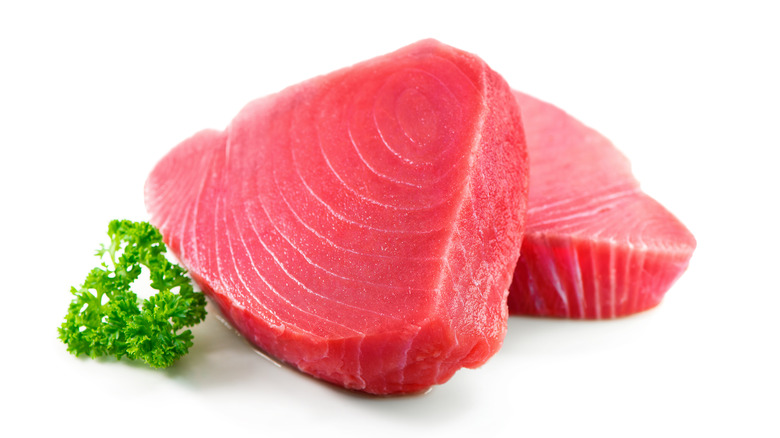Here's How You Should Really Be Storing Tuna
Whether you enjoy it from a can or pouch, from the fridge or freezer, you want your beloved tuna to stay as fresh as possible for as long as possible. There are tried and true measures you can take to prolong the shelf-life of your tuna in whatever form you purchased it in.
Cans and pouches come with best-by and expiration dates that offer some guidance, but how and where you store them can expedite their spoilage. Fresh and frozen tuna is a bit more obscure because there really is no way to know where it's been and how it was handled prior to it landing on a bed of ice in the seafood case. But there are precautions you can take at home to keep it fresh and safe.
The best tools to figure out whether or not your tuna is still good to eat are your senses: smell, sight, and touch. But when all is said and done, when it comes to tuna (or any food, really) one rule reigns supreme: When in doubt, throw it out. But here are some of the best ways to store different kinds of tuna to avoid a premature trip to the garbage can.
How to store unopened canned tuna
It seems like tuna in a sealed can will last for eons, hence why it is considered a pantry staple and in-case-of-emergency apocalypse necessity. That can of tuna has a few common enemies, however: temperature, moisture, and contact with anything or anyone that can harm it. Tinned tuna is best kept at room temperature or cooler. High heat can, and will, shorten its lifespan and cause spoiling and render it unsafe for consumption. So the shelf above your oven is probably not the best spot in the kitchen to stack your cans, nor is keeping a backup stash in your garage in the summer. It is also best stored away from moisture to inhibit rusting so storing them under the sink is also not a safe bet. Keeping the cans elevated and off the floor away from human (or pet) traffic will prevent denting or crushing. The same goes for the pouched varieties of tuna to prevent puncturing or leaking.
If dented deeply, bacteria can enter the can at the sharp edges. A bulging can of food can indicate botulism and should not be eaten. Check the outside for any signs of damage and the inside for any changes in color or texture. And when in doubt, trust your nose. If it smells off once opened, into the trash bin it goes. When properly stored, a can of tuna will last about four years on average. The pouched version will last about three.
How to store opened canned tuna
Once that can of tuna has been opened, its shelf-life is slashed substantially. However, there are some measures you can take to store it properly and make sure none of that leftover tuna meat goes to waste. The first thing you want to do is transfer the tuna into a glass or plastic container with a tight-fitting lid. This will keep odors and flavors from elsewhere in your fridge permeating the meat, and it will halt the growth of bacteria. Stored in an airtight container in the fridge, the canned tuna will last about one to two days before it's past its prime.
Transferring the tuna out of the can is more about preserving the flavor and quality of the meat as opposed to a safety or food poisoning issue. Small amounts of the metal can leach into the tuna, and while not harmful, that may lend a metallic aftertaste to the meat.
How to store fresh tuna in the refrigerator
To properly maintain the integrity and safety of fresh tuna, it should go from the fishmonger to your cold fridge as swiftly as possible. To store it, remove it from the store's packaging and soak up any excess moisture with a paper towel. You then want to tightly wrap it in plastic wrap, aluminum foil, or an airtight container. Store the tuna in the coldest part of your fridge, which is usually higher up and near a wall. You can always place the wrapped meat in a bag or bowl with ice or lower your fridge's thermostat if you're concerned about temperature.
Ideally, you want to consume it on the same day you purchase it. The vast majority of fresh tuna you purchase at the store has been previously frozen and then thawed, which ultimately shortens its fridge shelf-life. You can always ask the monger whether it's been frozen or not, but if you're buying it at a grocery store or in a landlocked state, it's safe to say the fish arrived there frozen. Tuna is often frozen by industrial freezing methods while still on the boat immediately after being caught — and that's a good thing to maintain the freshness, safety, and integrity of the meat. However, the general rule of thumb is that tuna you purchased fresh will last up to two days if properly stored in your refrigerator.
How to store fresh tuna in the freezer
If you've purchased fresh tuna and won't be able to consume it by the 48-hour mark, there are a few steps you can take to properly freeze it to be used at a later date. If you have more than one tuna steak or bought a large loin that will serve more than one person, you'll want to portion it out into individual servings and freeze them separately so they're faster to defrost. Just like storing fresh tuna in the fridge, you want to wipe the meat with a paper towel to remove any excess water or moisture. This will prevent ice crystals from forming on the surface in the freezer. You also want to wrap it securely in plastic wrap — double-wrapping will ensure it is absolutely airtight. You can then place the individually wrapped pieces in a bag or container for stackable storing.
Freezing tuna steaks comes with a suggested extra step of dipping them in one tablespoon of ascorbic acid or salt and water solution to extend the freshness of the meat prior to wrapping and freezing. Fresh tuna that you've frozen will last up to three months in your icebox. Adding the date you froze the tuna will help guarantee you don't forget about using it in time.
How to tell if your tuna has gone bad
When it comes to deciphering if your tuna has gone bad, for the most part, your nose knows. Whether canned, fresh, or frozen, tuna that has turned the corner will just smell off. Not that tuna has an exceptionally pleasant smell to begin with, but when it's past its prime you will know with one whiff.
Aside from any physical damages to the can that may indicate bacteria has snuck in or an expiration date well in the past, canned tuna meat will take on a metallic scent as opposed to fishy. It will smell like anything other than tuna. You may also see black or dark brown lines, or even green meat, throughout the fish indicating it is not safe to consume. If you make it past the smell and sight test, one bite of rancid tuna will seal the deal to put down the fork.
Fresh tuna should smell like cucumbers or a faint hint of the ocean. Once it has spoiled, it will take on a strong fishy and sour smell. The meat will also appear slimy and possibly cloudy as opposed to shiny and slick. It may even take on a brownish shade as opposed to the fresh, bright pinkish watermelon red.
Frozen tuna will exhibit the same signs as spoiled fresh meat once it is defrosted. If you see signs of freezer burn or greying patches while it's still frozen, it's not a safe bet.





